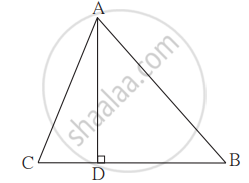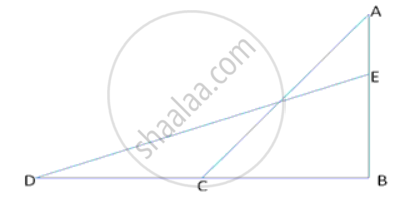Advertisements
Advertisements
प्रश्न
Which of the following can be the sides of a right triangle?
1.5 cm, 2 cm, 2.5 cm
In the case of right-angled triangles, identify the right angles.
उत्तर
1.5 cm, 2 cm, 2.5 cm
(1.5)2 = 2.25
(2)2 = 4
(2.5)2 = 6.25
Here,
2.25 + 4 = 6.25
(1.5)2 + (2)2 = (2.5)2
The square of the length of one side is the sum of the squares of the lengths of the remaining two sides. Hence, these are the sides of a right-angled triangle.
Right angle will be in front of the side of measure 2.5 cm.
APPEARS IN
संबंधित प्रश्न
In ∆ABC, ∠BAC = 90°, seg BL and seg CM are medians of ∆ABC. Then prove that:
4(BL2 + CM2) = 5 BC2

In ∆ABC, seg AD ⊥ seg BC, DB = 3CD.
Prove that: 2AB2 = 2AC2 + BC2

O is any point inside a rectangle ABCD.
Prove that: OB2 + OD2 = OC2 + OA2.
In triangle PQR, angle Q = 90°, find: PR, if PQ = 8 cm and QR = 6 cm
The sides of the triangle are given below. Find out which one is the right-angled triangle?
11, 60, 61
The foot of a ladder is 6m away from a wall and its top reaches a window 8m above the ground. If the ladder is shifted in such a way that its foot is 8m away from the wall to what height does its tip reach?
In a triangle ABC right angled at C, P and Q are points of sides CA and CB respectively, which divide these sides the ratio 2 : 1.
Prove that: 9AQ2 = 9AC2 + 4BC2
In a triangle ABC right angled at C, P and Q are points of sides CA and CB respectively, which divide these sides the ratio 2 : 1.
Prove that : 9(AQ2 + BP2) = 13AB2
The hypotenuse of a right angled triangle of sides 12 cm and 16 cm is __________
In ∆PQR, PD ⊥ QR such that D lies on QR. If PQ = a, PR = b, QD = c and DR = d, prove that (a + b)(a – b) = (c + d)(c – d).
